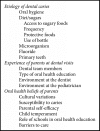A Community-Based Participatory Research Approach to Understand Urban Latino Parent's Oral Health Knowledge and Beliefs
- PMID: 28465687
- PMCID: PMC5390545
- DOI: 10.1155/2017/9418305
A Community-Based Participatory Research Approach to Understand Urban Latino Parent's Oral Health Knowledge and Beliefs
Abstract
The aim of this study is to describe oral health knowledge, behaviors, and beliefs of Latino parents with children under the ages of 6 years and to conduct a needs assessment with Latino families to better understand the challenges in maintaining oral health for their children. The investigator collaborated with a community serving the organization to recruit Latino primary caregivers for focus groups interviews and 30 primary caregivers were recruited. The focus groups data was transcribed and analyzed using a grounded theory approach using QDA Miner software. Findings from the focus groups demonstrate that the primary caregivers described barriers in maintaining oral health for their children including cultural barriers, child's temperament, lack of time, and easy access to high-risk foods. All participants said that they wanted to receive information on the oral health of their children; they wanted the dentist or the hygienist to demonstrate oral hygiene practices and explain to them the reasons for oral health behaviors. Although the primary caregivers recognized some factors related to caries development, their knowledge was limited in depth. Culturally appropriate oral health education is required for this population, which could lead to more adherent oral health behavior and a higher sense of self-efficacy in Latino parents.
Figures




References
-
- U.S. Department of Health and Human Services. Oral Health in America: A Report of the Surgeon General. Rockville, Md, USA: National Institute of Dental and Craniofacial Research, National Institutes of Health; 2000.
-
- Dye B. A., Thornton-Evans G., Li X., Iafolla T. J. Dental Caries and Sealant Prevalence in Children and Adolescents in the United States, 2011-2012. US Department of Health and Human Services, Centers for Disease Control and Prevention, National Center for Health Statistics; 2015.
-
- Calanan R., Juhl A., Mauritson K. The Basic Screening Survey: Children's Oral Health Screening Colorado, 2011-2012. Denver, Colo, USA: Colorado Department of Public Health and Environment; 2012.
Grants and funding
LinkOut - more resources
Full Text Sources
Other Literature Sources

